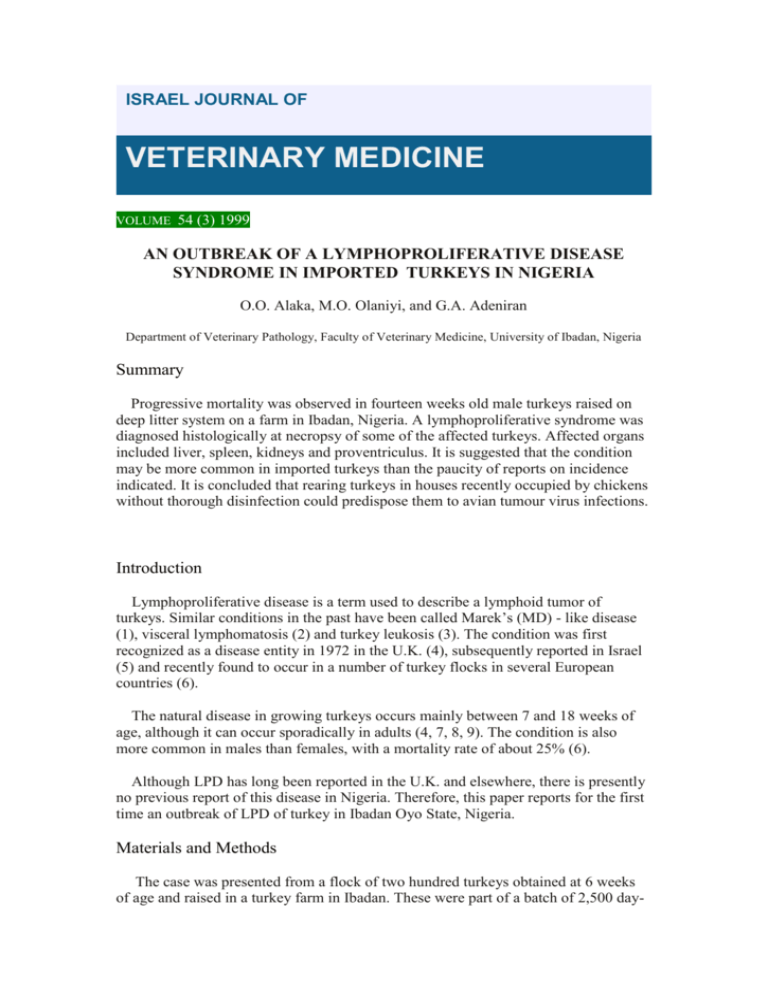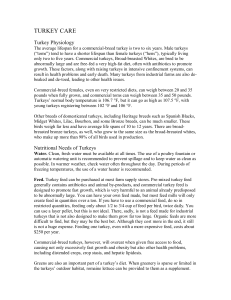Read full Article
advertisement

ISRAEL JOURNAL OF VETERINARY MEDICINE VOLUME 54 (3) 1999 AN OUTBREAK OF A LYMPHOPROLIFERATIVE DISEASE SYNDROME IN IMPORTED TURKEYS IN NIGERIA O.O. Alaka, M.O. Olaniyi, and G.A. Adeniran Department of Veterinary Pathology, Faculty of Veterinary Medicine, University of Ibadan, Nigeria Summary Progressive mortality was observed in fourteen weeks old male turkeys raised on deep litter system on a farm in Ibadan, Nigeria. A lymphoproliferative syndrome was diagnosed histologically at necropsy of some of the affected turkeys. Affected organs included liver, spleen, kidneys and proventriculus. It is suggested that the condition may be more common in imported turkeys than the paucity of reports on incidence indicated. It is concluded that rearing turkeys in houses recently occupied by chickens without thorough disinfection could predispose them to avian tumour virus infections. Introduction Lymphoproliferative disease is a term used to describe a lymphoid tumor of turkeys. Similar conditions in the past have been called Marek’s (MD) - like disease (1), visceral lymphomatosis (2) and turkey leukosis (3). The condition was first recognized as a disease entity in 1972 in the U.K. (4), subsequently reported in Israel (5) and recently found to occur in a number of turkey flocks in several European countries (6). The natural disease in growing turkeys occurs mainly between 7 and 18 weeks of age, although it can occur sporadically in adults (4, 7, 8, 9). The condition is also more common in males than females, with a mortality rate of about 25% (6). Although LPD has long been reported in the U.K. and elsewhere, there is presently no previous report of this disease in Nigeria. Therefore, this paper reports for the first time an outbreak of LPD of turkey in Ibadan Oyo State, Nigeria. Materials and Methods The case was presented from a flock of two hundred turkeys obtained at 6 weeks of age and raised in a turkey farm in Ibadan. These were part of a batch of 2,500 day- old poults imported from British United Turkeys (BUT) which were raised together before being distributed to other farms. The clinical picture was that of weakness, anorexia, ruffled feathers, reduced weight gain and about 10% mortality within two weeks of the onset of disease. The turkeys were fed commercial turkey grower ration. At necropsy, the birds were found to have consistently markedly enlarged liver, spleen and proventriculus. In one bird, the kidneys were also enlarged. The livers in all the birds had milliary grey-white foci with diffuse yellowish mottling. There was a firm mass of about 2 cm in diameter located towards the tip of one of the lobes in one liver. Sections from the liver, kidney, spleen and proventriculus were fixed in 10% buffered formalin solution, processed routinely for histopathological examination and stained with Haematoxilin and Eosin (H&E). A tentative diagnosis of a lymphoid tumour was made based on the post-mortem lesions with differential diagnoses of reticuloendotheliosis LPD and Marek’s disease. Results Histopathological findings Aggregates of pleomorphic lymphoid cells (mature lymphocytes, lymphoblasts, plasma cells and reticular cells) were observed diffusely infiltrating the liver with marked dissociation of hepatic cords and necrosis of the adjacent hepatocytes (Fig. 1). Fig.1. Histological section of the liver showing aggregates of pleomorphic limphoid cells, necrosis and dissociation of hepatic cords. Arrow - mitotic figures. Similar infiltrating cells were observed in the lamina propria of the proventricular mucosa and the interstitium of the proventricular glands with severe coagulative necrosis of the glandular epithelial cells (Fig. 2). Fig. 2(a). Histological section of proventriculus showing coagulative necrosis of glandular epithelial cells and infiltration of the lumina propria by pleomorphic lymphoid cells. Fig. 2(b). Histological section of proventriculus at higher magnification showing severe infiltration of the lamina propria by cells of the lymphoid series. Arrow - mitotic figures. In addition, the interstitium of affected kidneys showed thick infiltrations by similar cells. Numerous mitotic figures were also seen in the liver, spleen and proventricular sections (Figs. 1 & 2, arrow). The observed lesions in the various organs are consistent with those of LPD or Marek’s disease of turkeys as described previously (4, 6, 8). Discussion LPD of turkey was first recognized as a disease entity in 1972 in the U.K. (4,7). Since that time it has been reported in Israel (5) and several other countries in Europe (6). There have been no previous reports of LPD cases in the indigenous breeds of turkeys. This rarity of documented cases in Nigeria may be attributed to lack of clinical information on the disease or misdiagnosis. The alternate rearing of chickens and turkeys on the same contaminated litter has been considered an epidemiological hypothesis of transmission by the litter of an oncogenic agent for turkeys (10). The situation in this case is similar though the birds were not raised on litter previously occupied by chickens, but the pen was recently used for laying birds on deep litter. It is also worthy of note that other birds of the same batch reared from 6 weeks of age at various locations in the country did not suffer similar outbreaks. At present, there is little or no information on the prevention and control of LPD. However, in addition to avoidance of rearing turkeys in houses recently occupied by chickens, commercial turkey breeders should selectively breed LPD - resistant turkey strains. Above all, utmost attention should be paid to excellent management and hygiene procedures. Acknowledgments: The authors are grateful to the technical and secretarial staff of the department of Veterinary Pathology, University of Ibadan, for photomicrography and typing of the manuscript. References 1. Busch, R.H. and Williams, L.E.: A Marek disease-like condition in Florida Turkeys. Avian Dis., 14: 550-554, 1970. 2. Simpson, C.F., Anthony, D.W. and Young, F.: Visceral lymphomatosis in a flock of turkeys. J. Am. Vet. Med. Assoc. 130: 93-96, 1959. 3. McKee, G.S., Lucas, A.M., Denington, E.N. and Love, F.C.: Separation of leukotic and non-leukotic lesions in turkeys on the inspection line. Avian Dis., 7: 1930, 1963. 4. Biggs, P.M., Milne, B.S., Frazier, J.A., MacDougall, J.S. and Stuart, J.C.: Lymphoproliferative disease in turkeys. Proc. 15th World’s Poult Congr. 55-56, 1974. 5. Perk, K., Lanconescu, M., Yaniv, A. and Zimber, A.: Lymphoproliferative disease in turkeys - structure, ultrastructure and biochemistry. Refuah Vet. 35: 29, 1978. 6. Biggs, P.M.: In: Calnek, B.W., Barnes, H.J., Beard, C.W., Reid, W.M. and Yoder, H.W. (eds.): Diseases of poultry, 9th editio, Iowa State University Press, Iowa, U.S.A. 456-459. 1991. 7. Biggs, P.M., MacDougall, J.S., Frazier, J.A. and Milne, B.S.: Lymphoproliferative disease of turkeys. Clinical aspects. Avian Dis. 7: 133-139, 1978. 8. Ianconescu, M., Perk, K., Zimber, A. and Yaniv, A.: Reticuloendotheliosis and lymphoproliferative disease of turkeys. Refuah Vet. 36: 2-21, 1979. 9. Gordon, R.F.: Poultry diseases. ELBS & Bailliere Tindall, London, 78-81, 1979. 10. Duivon,D., Alogninoywa, T. and Negrel, G.: Suspicion of poultry tumoral disease transmitted to turkey by the litter. Rev. Med. Vet. 146: 321-325, 1995.








